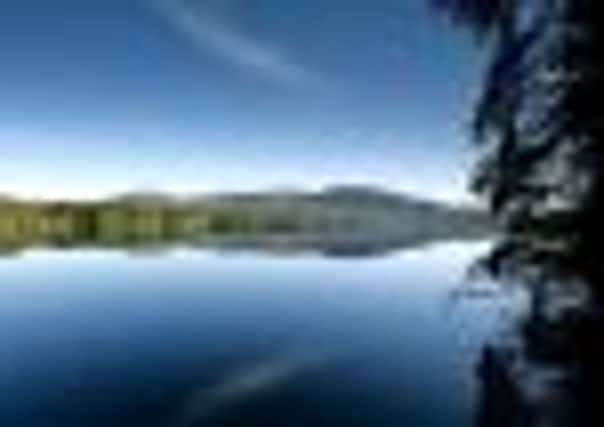The ospreys’ return


After Loch Ness, Loch Garten is the best-known piece of freshwater in Scotland but its fame rests not on a mythical beast lurking somewhere in its depths but on a very real pair of spectacular fish-eating hawks flying over the surface.
Few birds look as graceful as an osprey quartering a Highland loch for trout, and there is nothing more dramatic in Britain’s bird world than that final plunge down into the blue water followed by its triumphal emergence with a wriggling fish.
Advertisement
Hide AdAdvertisement
Hide AdYet the charismatic osprey was wiped out by Victorian gamekeepers and ghillies who feared the bird’s fish-catching prowess was considerably better than the lairds who paid their wages, and there would be precious few fish left for their employers to hook.


This persecution resulted in ospreys being extinct as a British nesting species for many decades, but in 1954 one pair began to breed at Loch Garten, a small and ethereal-looking sheet of water deep in the Abernethy Forest to the north of the Cairngorms. Their eyrie was built in a venerable Scots Pine tree, right next to the one that’s in use today, and it became the focus of the kind of security operation you might think was more worthy of the Crown Jewels.
Since then, of course, ospreys have spread throughout Scotland and now also breed in England and Wales, but here in the Abernethy Forest the nesting site of those original comeback kids has an almost tangible aura about it.
The RSPB’s long-serving manager at Loch Garten, Richard Thaxton, is on hand to relate to visitors the story of the bird’s legendary return, and to point out that by using the binoculars and telescopes that are provided or watching the CCTV screens it’s possible to distinguish one bird from another by the coloured rings attached to their legs.
Advertisement
Hide AdAdvertisement
Hide AdThis has allowed the birds’ lives to be turned into a kind of soap opera, and in an eggshell here’s the story so far: EJ is the female who spends most of her time lovingly attending to her chicks, but no one’s quite sure whether their dad is a male called Odin or another one by the name of Henry that’s been hanging around. A few years back, in a fit of jealous rage, Henry turned up and kicked the eggs out of the nest which EJ had made with Odin.
The other big bird at Loch Garten – quite literally – is the capercaillie, a huge and very rare grouse-like species that is in long-term decline because of climate change interfering with its sensitive breeding cycle and the vulnerability of its eggs and young to predation by a local member of the weasel family, the pine marten.
If you want to see a capercaillie the good news is that it’s now largely confined to these 11 square miles of woodland. But the bad news is that it involves setting your alarm for four or five am in spring and summer and getting out in the half-light of dawn when the shaggy-throated males strut their stuff with the hens. For the rest of the day the birds skulk in the woodland’s thick under-storey and finding one is, well, like looking for a real needle beneath the thousands of pine trees.
The Abernethy Forest is Britain’s largest remaining tract of ancient Caledonian pines and has a sometimes boggy floor of ferns, mosses and lichens. The woods were formed at the end of the last ice age and they once cloaked most of the British Isles. The one per cent that survives is right here, where the River Nethy meets the River Spey.
Advertisement
Hide AdAdvertisement
Hide AdAn extensive network of public footpaths has been created through the woods, all of them well waymarked and there are links to the two villages of Nethy Bridge and Boat of Garten.
Red squirrels are fairly common in the forest. There are also two more birds you won’t see in Yorkshire, so keep an ear out for the crested tit’s distinctive purring trill and your eyes peeled for flashes of orange-red Scottish crossbills in the high branches.
The Abernethy Forest is bookended by two small towns for eating and entertainment. Further up the River Spey is Aviemore, a somewhat brash skiing and hill-walking centre, downstream from Nethy Bridge is the more interesting Grantown-on-Spey, a solid stone-built town with lovely greens and offering an interesting couple of hours’ browsing along its main street. Macleans bakery’s house speciality is that curiously ubiquitous Scottish dish, macaroni cheese.
Getting there
Mountain Bear Lodge at Nethy Bridge is available from Great North Lodges, Ltd, Aviemore. Tel. 0870 2416970 or visit www.greatnorthlodges.co.uk
Advertisement
Hide AdAdvertisement
Hide AdInformation about Abernethy Forest, including guided walks, is available at the Explore Abernethy Ranger Base, Nethby Bridge Community Centre. Tel. 01478 821565 or visit www.exploreabernethy.co.uk
The RSPB’s Loch Garten reserve is signposted from Boat of Garten. The Osprey Centre is open daily, from April to late August, and in spring the Caper-watch is 5.30am-8am. The wider reserve is open all year round. Details in the reserves guide at www.rspb.org.uk
The Strathspey Steam Railway runs between Aviemore, Nethy Bridge and Broomhill. For timetables visit www.strathspeyrailway.net
The Old Bridge Inn is at Dalfaber Road, Aviemore, PH22 1PU. Tel. 01479 811137 or visit www.oldbridgeinn.co.uk